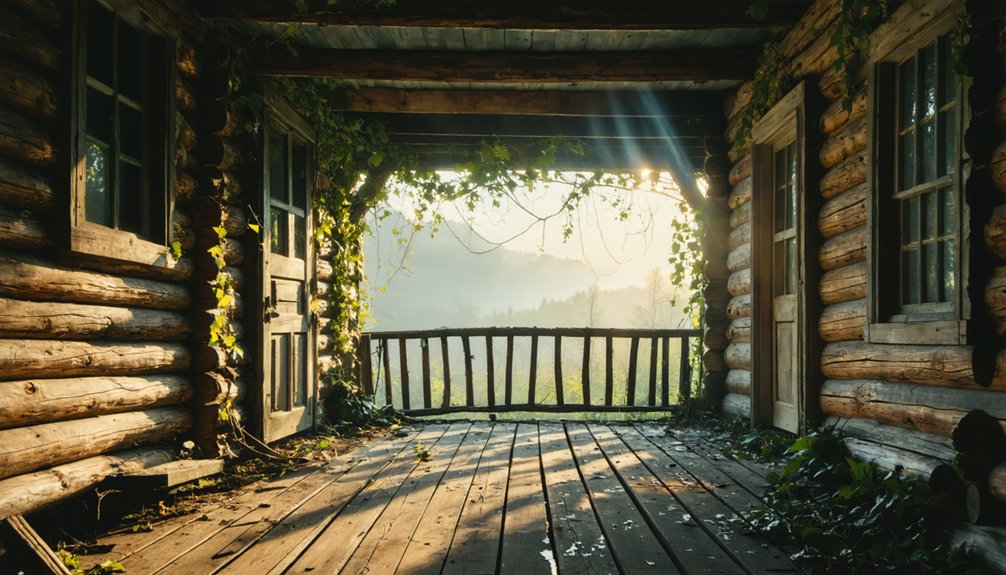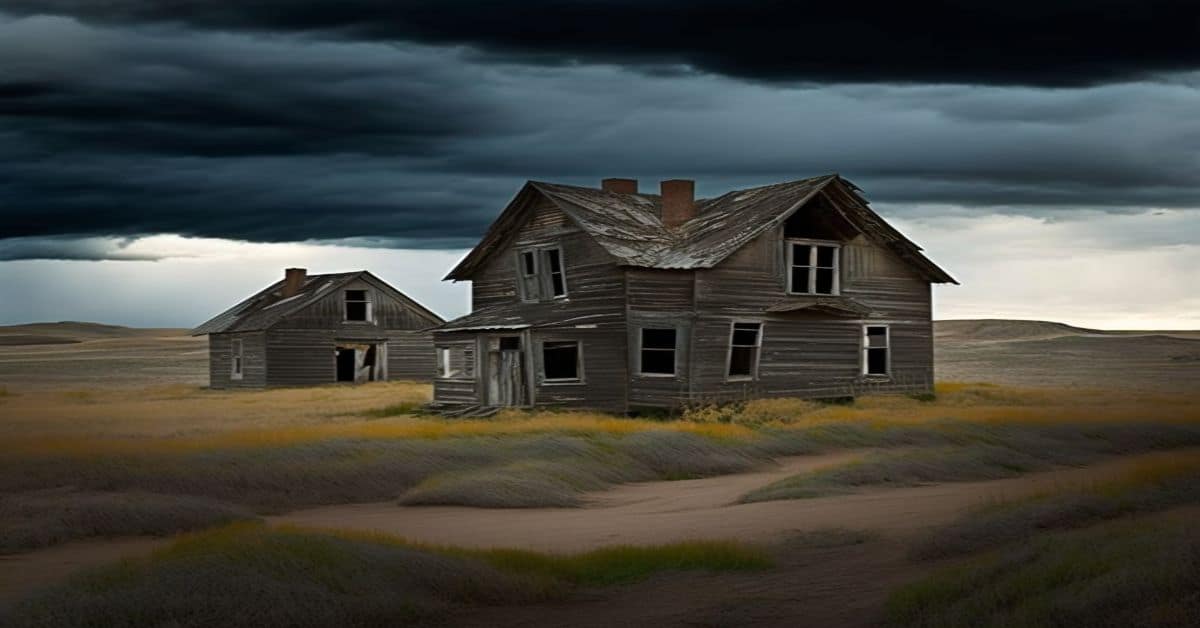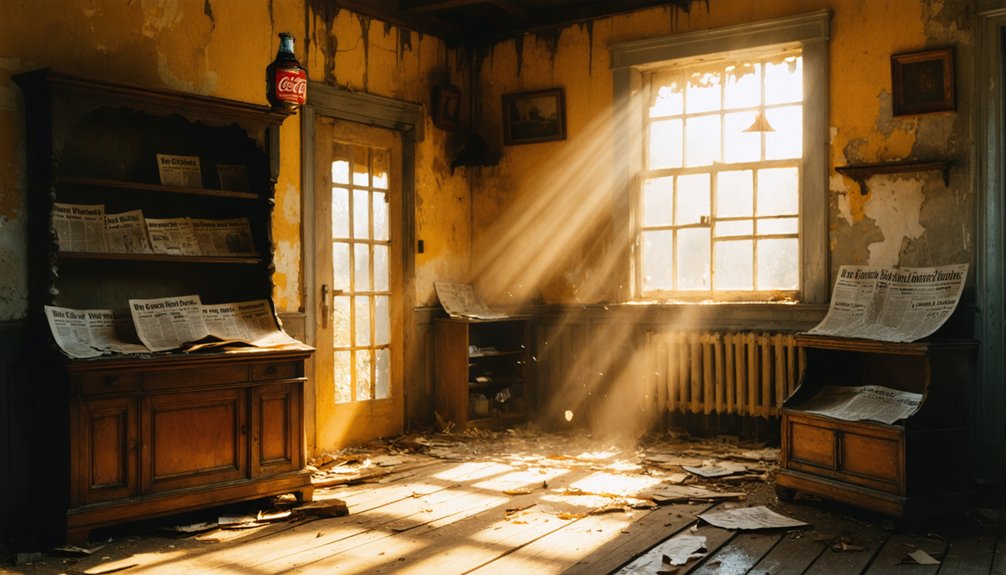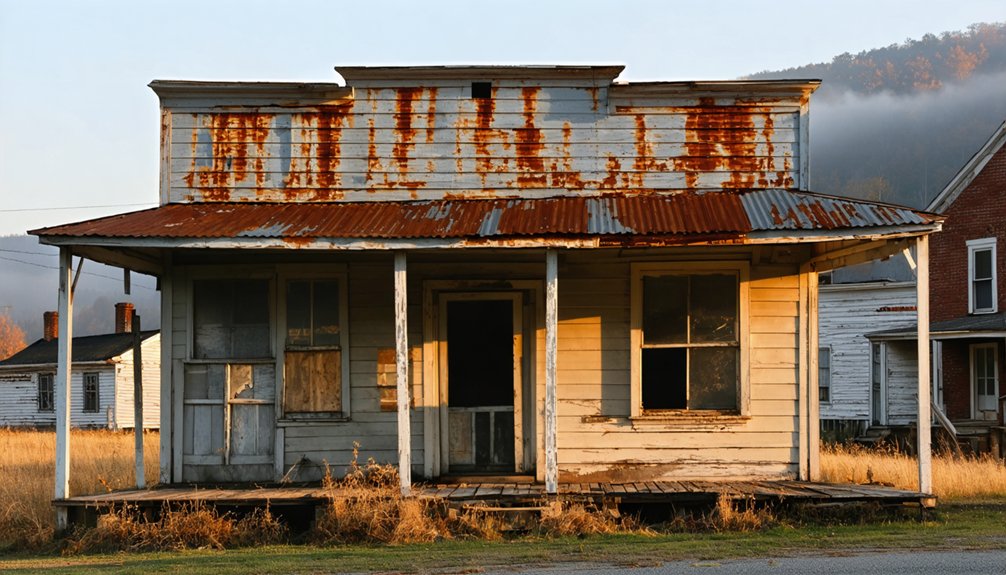You’ll find Dog Trot nestled in Kentucky’s wooded frontier, where pioneer families established homesteads after the American Revolution. The ghost town‘s signature dogtrot houses, featuring two log cabins connected by an open breezeway, still stand as silent witnesses to early settlement life. Local legends tell of shadowy figures, mysterious lights, and unexplained phenomena near abandoned structures and dense forests. The town’s dark history of moonshine operations and mining disputes holds secrets waiting to be uncovered.
Key Takeaways
- Dog Trot was a Kentucky frontier settlement known for its distinctive architectural style featuring houses with open-air breezeways between two cabins.
- The ghost town’s dark history includes TVA displacement, mining disputes, and numerous unexplained disappearances in the surrounding dense forests.
- Local folklore tells of supernatural occurrences, including sightings of shadowy figures, mysterious lights, and a spectral black dog named Shuck.
- The abandoned settlement features hidden passages allegedly used by moonshiners and contains automotive graveyards that contribute to its eerie atmosphere.
- Preservation efforts began in the 1980s to protect the remaining dogtrot houses and document the settlement’s historical significance in Kentucky’s frontier history.
Origins of a Frontier Legacy
As settlers pushed into Kentucky’s frontier regions after the American Revolution, they established homesteads that would define the area’s architectural heritage, including the distinctive dogtrot house style.
You’ll find these early settlements emerged along waterways and strategic locations, where pioneers faced the constant challenge of carving out a life amid Native American conflicts and harsh wilderness conditions.
Frontier architecture reflected the urgent needs of the time – you’d first see simple log structures with defensive features, built from locally available materials.
As families gained their footing, they’d expand these basic shelters, often incorporating elements from their German, British, and Scotch-Irish backgrounds. The adaptable dogtrot design, with its signature central breezeway, proved ideal for Kentucky’s warm climate.
Settlement patterns followed a careful progression from communal forts to individual farmsteads, where extended families worked together to clear land and establish lasting communities. Early settlers like Captain Nathaniel Hart Sr. managed 640-acre plots, requiring significant labor to transform wilderness into productive farmland.
The Architecture of Dog Trot Houses
The distinctive dogtrot house emerged as one of the most innovative architectural solutions to Kentucky’s humid climate and frontier living conditions.
You’ll find these architectural features defined by two separate log cabins joined by an open breezeway under a single roof. This clever dogtrot design maximizes natural ventilation while providing practical living spaces. Originally constructed as single-story dwellings, these homes exemplified efficient frontier architecture.
- Each cabin serves distinct purposes – one side for living and cooking, the other for sleeping quarters
- Dual chimneys flank the structure, providing heat and maintaining symmetrical balance
- Strategic window placement creates cross-breezes through the breezeway
- The east-west orientation shields inhabitants from intense sun exposure
The rustic log construction combines with tin roofing to create a durable shelter that’s stood the test of time in Kentucky’s challenging climate, embodying the independent spirit of frontier life. These homes were often constructed using local building materials sourced directly from the surrounding landscape.
Local Legends and Folklore
If you’re walking through Dog Trot after sunset, you’ll encounter stories of shadowy figures darting between the abandoned houses and mysterious lights flickering in windows where no electricity has flowed for decades.
Similar to the unnerving atmosphere at Allendale train tunnel, disembodied voices and screams have been reported by those exploring Dog Trot’s abandoned streets at night.
Local residents tell of a network of hidden passages beneath the old homes, originally used by moonshiners during Prohibition and later serving as emergency escape routes during mining disputes.
The passages have sparked persistent legends of unexplained footsteps echoing underground and strange knocking sounds that seem to rise from beneath the floorboards of the remaining structures.
Many claim to have seen a spectral black dog named Shuck wandering the area near an old mine shaft, believed to appear as an omen before mining accidents.
Mysterious Night Encounters
Deep within Kentucky’s coal country, mysterious night encounters have shaped the region’s rich folklore for generations.
You’ll hear haunting whispers of the black dog that leads miners to the Devil’s Mouth, where spectral shadows dance in the darkness before tragedy strikes.
Along Red Dog Road, you might glimpse a miner’s ghostly lamp searching endlessly for justice. Flickering lights still appear at night, reminding locals of the deadly 1930s shooting.
- Watch for the phantom bride’s tears at Cumberland Falls, where her spirit lingers with her beloved near the rushing waters.
- Listen for unexplained bangs and echoes around abandoned mine shafts, echoing the region’s tragic past.
- Keep your distance from burned homesteads where female apparitions flee into the thick woods.
- Stay alert for drifting lights through the forest, marking the paths of lost miners who never made it home.
At Pine Mountain Range in Harland County, residents still speak of a woman’s spirit appearing in the window of an old house where burning gown flames drove her to a nearby creek.
Hidden Underground Passages
Beneath crumbling dogtrot houses and overgrown settlement areas of Dog Trot, Kentucky, local legends whisper of mysterious underground passageways that once served as essential escape routes.
You’ll find tales of hidden chambers accessible through trap doors and loose floorboards, where settlers allegedly stored valuables and created secret escape paths during times of conflict.
The region’s natural landscape of caves and ridges lent itself perfectly to these clandestine networks.
Between the elevated floors and enclosed breezeways of traditional dogtrot structures, you might’ve discovered concealed spaces connecting multiple houses.
Settlers constructed their homes raised off the ground, creating natural spaces beneath the structures that could have concealed underground pathways.
Like many European folklore tunnels, these passages were said to link important community buildings and homesteads.
While treasure myths abound, historical records show that early Kentucky settlers, including Long Hunters, did utilize underground spaces for protection.
The area’s documented cave systems, like Hines Cave near Burnside, support the possibility of such hidden passages.
Pioneer Families and Settlement History
While Daniel Boone and John Findley first explored Madison County, Kentucky in 1769, permanent settlement didn’t begin until after the Transylvania Company’s purchase of 20 million acres from the Cherokee.
The pioneer struggles included defending against Indigenous attacks, with Twetty’s Fort serving as the first fortification near today’s Bluegrass Army Depot.
Settlement challenges forced families to build crude shelters before establishing permanent homes.
- You’ll find evidence of early settler life in the hastily built lean-tos dug into hillsides.
- Your ancestors cleared land by girdling trees, using the timber for building materials.
- You can trace the evolution from basic three-door cabins to elaborate dogtrot houses.
- You’ll discover how marriage and family growth drove home expansions and improvements.
Mysterious Disappearances and Haunted Tales
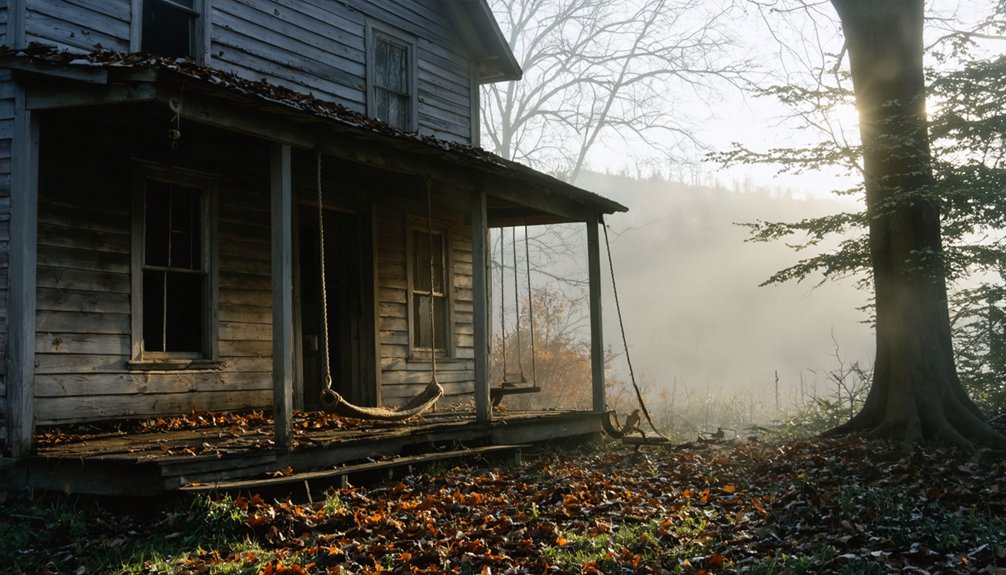
As mysterious disappearances began plaguing Dog Trot in the late 1800s, the settlement’s reputation for supernatural occurrences grew stronger.
You’ll find countless disappearance theories surrounding the dense forests and hidden automotive graveyards that dot the landscape. Local folklore tells of the Dogman, a creature that’s said to stalk the abandoned trails near what was once the Morrison family homestead.
If you venture into Dog Trot today, you might hear stories of ghostly sightings near the old settlement’s ruins, where strange lights and unexplained sounds echo through the hollow.
The area’s dark history, shaped by TVA displacement and isolated terrain, has left an indelible mark on Kentucky’s cultural heritage, making it a focal point for paranormal investigators and folklore enthusiasts.
Preservation and Modern Rediscovery
Since the late 1980s, preservation efforts in Dog Trot have centered on the remarkable dogtrot houses that once defined this Kentucky settlement.
Local communities and historical societies are now leading an architectural revival, breathing new life into these unique structures that showcase the region’s pioneer spirit.
Historical preservation brings fresh purpose to Dog Trot’s pioneering architecture, as grassroots efforts revitalize these cherished landmarks.
You’ll discover how these preservation projects are transforming Dog Trot through:
- Community engagement programs that connect residents with their architectural heritage
- Innovative restoration techniques blending traditional materials with modern sustainability
- Digital documentation efforts preserving the stories of original settlers
- Educational initiatives drawing tourists to explore Kentucky’s frontier history
The Marion County dogtrot house, restored by the Caldwells, stands as a symbol of the town’s commitment to protecting its historical legacy while adapting these timeless designs for future generations.
Frequently Asked Questions
Are There Any Remaining Dogtrot Houses Still Standing in Dog Trot Today?
You won’t find any surviving dogtrot architecture in Dog Trot today, despite the historical significance of these homes in Kentucky. The ghost town’s structures haven’t withstood time’s passing.
What Happened to the Original Town Records and Documents of Dog Trot?
You won’t find original documents from Dog Trot in any public archive – they’ve been lost to time, floods, fires, and neglect. Their historical significance makes this loss particularly devastating.
When Was the Last Reported Sighting of the Legendary Dogman Creature?
Like shadows dancing in twilight, your search for the latest dogman sightings leads to early 2024, when witnesses near Land Between the Lakes reported encounters with these legendary creatures during documentary filming.
How Accessible Is Dog Trot’s Location to Modern-Day Visitors?
You’ll find limited road access through unpaved rural routes, with no visitor amenities available. You’ll need GPS coordinates and a reliable vehicle to reach this remote, undeveloped location in Menifee County.
Did Any Archaeological Excavations Ever Take Place in Dog Trot?
Like a blank page in history’s book, you won’t find any documented archaeological excavations here. There’s no record of formal digs or excavation findings that would reveal Dog Trot’s archaeological significance.
References
- https://burnaway.org/magazine/dogtrotting/
- https://www.youtube.com/watch?v=QiYWLUaO9hU&vl=en-US
- https://en.wikipedia.org/wiki/Dogtrot_house
- https://www.onlyinyourstate.com/trip-ideas/kentucky/blue-heron-ghost-town-ky
- http://www.columbiamagazine.com/index.php?sid=42125
- https://wbkr.com/ky-town-doesnt-exist/
- https://digitalcommons.unl.edu/cgi/viewcontent.cgi?article=1002&context=etas
- https://heritage.ky.gov/Documents/PioneerLogHouse.pdf
- https://libertyhall.org/blog/tracing-harts-frontier-urban-servitude
- https://www.thestoryoftexas.com/discover/campfire-stories/frontier-folk
